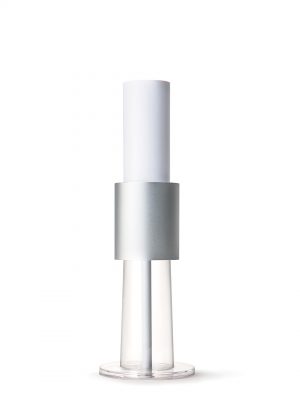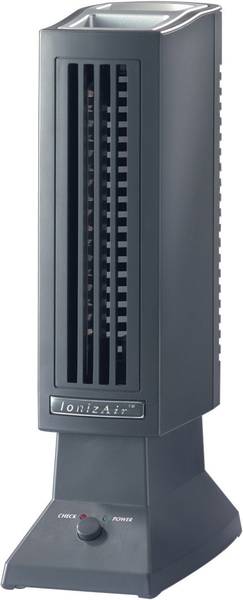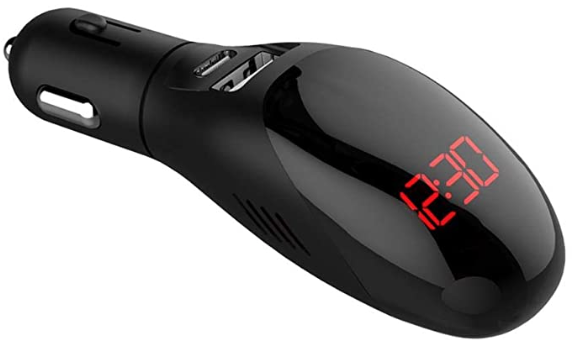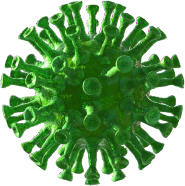Aerosol transmission is easy to turn off. Contamination by a contaminated atmosphere indoors is thus reduced to virtually zero. Authoritative scientific Nature already reported on it in 2015. At the time, influenza was the main candidate for aerosol transmission. The conclusion:
Most importantly, we demonstrate that this technology can be used to prevent airborne influenza virus infections.
Nature https://www.nature.com/articles/srep11431
This peer-reviewed study was conducted with a 'Lightair Ionflow', but it is about the ionization function of that device. It is often advertised on websites as 'removes unpleasant odours', 'the freshness of a forest or waterfall' or 'good for your health' and other questionable claims. Many humidifiers and air purifiers are also equipped with a (small) ionizer. Ionizers come in all shapes and sizes, for cars up to and including rooms of hundreds of cubic meters. The producers themselves do not seem to fully realize that there is currently a market for it.
[On the removal of ultrafine particles (aerosols)]
Air ionizers are increasingly used to clean indoor environments from particle pollution. We tested the efficiency of a small negative ion generator (Aironic AH-202) in removing ultrafine particles from indoor environments. In the enclosed chamber studies, 70% of the particles were removed by the ionizer in 15 minutes. In general, the efficiency of particle removal decreased as the room became larger and if there was more ventilation [then the air is already cleaner by itself, particles are also removed and the purification effect is therefore smaller].
We conclude that air ionizers are more suitable for removing ultrafine particles from rooms larger than about 25 m3 [a room of about 3x3m]. The research also showed that small ions produced by the ionizer, placed in one chamber, were carried by the air conditioning system to other chambers, effectively removing particles from the air in these chambers as well.
Sciencedirect.com, ,Journal of Electrostatics 2017: Efficiency of ionizers in removing airborne particles in indoor environments,

The RIVM writes earlier, in 2010, in an information sheet the findings after studying various studies:
Ionizers produce a stream of charged particles (ion flow) in the air that precipitate (fine) dust particles in the environment. Bacteria, viruses and fungi are captured and/or inactivated by ionizers through a combination of electrostatic deposition and biochemical alteration of membrane proteins.
RIVM. Ionizers and health
The RIVM also makes comments about ozone, but now, 10 years later, most modern ionizers are ozone-free. Maybe it's still something to be aware of.
Salvation for the hospitality industry and theaters?
Ionizers have been used for years in hospitals in China and also in America, in treatment rooms that must be virus-free and sterile,
You would say: Eureka, why are we still making such a fuss? Why are catering tents, theaters and public spaces not yet full of these devices? Shouldn't there be such a thing in every office or meeting room? Plexiglass walls and 1.5 meter setups: all wasted money. It is about controlling the indoor atmosphere. This does not reduce infection through coughing and sneezing, but someone who does that would be better off staying at home anyway.
Not (yet) embraced by RIVM
Filling the country with these devices is an investment of nothing, relatively speaking, especially compared to the economic disaster that the 'intelligent lockdown' and the 1.5 meter rule is calling upon us. Moreover, such a project could be a boost for the economy: certification of appliances, installation companies and public places all over the country.
We don't hear anything about it and I suspect that this has to do with the fact that negative ions act on aerosols, which in the official reading of the RIVM hardly play a role in the spread of the coronavirus.
So if you hang ionizers in a huge restaurant, which is now only allowed to admit 30 guests, or not: you will be fined anyway and if it is up to Grapperhaus, that can amount to about € 20,000,-.

Perfect addition to RIVM's 1.5 meter guideline
At the same time, it can be argued that the use of ionizers is in line with the one and a half meter guideline. If you are talking to someone close by and there is an unexpected cough or sneeze, that ionizer will not help. It is precisely in that situation that a little distance makes sense, no matter how small the chance is that you will be infected. After all, there are now (June 2020) hardly any corona patients who can infect you and you have to get really infected saliva or snot on your own mucous membranes (can also be done through the hands) if you want to be infected.
What is an ionizer for device?
It sounds like an expensive, medically hi-tech thing. Good news: they are already for sale from around € 33,-. More expensive models have for example
- a higher capacity
- can be operated with an app
- combine ionization with humidification and/or (HEPA) filtration
- have a timer function
- Auto-detect function (turn on when needed)
You can't think of it that crazy. There are models with USB power, for use in refrigerators, etc. etc. There are even ionizers for the car with a clock on it and two USB connections. Skillful!

Energy efficient
The power consumption depends on the capacity. An ionizer works from as little as 1 watt. With more bells and whistles on a device, power consumption naturally increases.
Things to look out for:
- Secondary production of ozone is poor. Modern models no longer have that, as far as I've seen.
- Quiet operation. There are models with a fan, if you don't have natural airflow or ventilation. Moving parts make a little more noise (noise).
- Dust filters that need to be replaced. HEPA filters do a good job, also because of viruses, but need to be replaced from time to time. Ionizers without filters can attract dirty particles to an electrostatic metal plate on cylinder. You only have to clean it with a damp cloth every now and then. Models without a 'collector', such as the car models, are maintenance-free.
They are available everywhere. Note: there are also humidifiers without ionization, you often can't filter for that in webshops so you really have to look at the specifications. Just Google or take a look at Coolblue humidifiers, Coolblue air purifiers or on Bol.com, The cheapest I found at conrad.nl
The reason to take a closer look at the technique was this Weltschmerz interview. Thanks to the channel that also makes dissident voices heard. (Although you do need to have a lot of time to spare to take in some information.)
Update 10 July
interview with Eliane Khoury. She was born in Nazareth and studied Chemical Engineering in Haifa (Israel). She then emigrated to the Netherlands and then studied Biochemistry at TU Delft. From there she founded the company VFA (Virus Free Air) Solutions in 2007 She developed a purification system in which Electro-static operation, ionization and mechanical filtration are combined. Koer talks enthusiastically about her ventilation ionization system as an effective remedy against the Coronavirus, but also against bacteria, nitrogen and particulate matter in indoor spaces. Even the WHO is now investigating. She endorses Maurice de Hond's call for a Delta Plan of Ventilation.
Update 24 August
By now I had expected more attention for companies such as https://www.vfa-solutions.com/ with products such as the ASPRA Lite. I have even approached companies that have similar products in their range. They were busy enough as it was and therefore didn't feel the need to put in extra marketing efforts.
On August 24 -two months after the post above- the AD comes with a message about a company that uses a filter that effectively removes the coronavirus from the air in buildings. Hey...!?
The company achieves this via positive ionization, in which the virus particles in the filter acquire a positive electrical charge and are thus rendered harmless.
AD.nl, August 24
If you have your own science editorial team and you always look forward to a scoop, why does it have to take months before you post such a message? Is journalism in such a bad state? I can't get my head around it.

